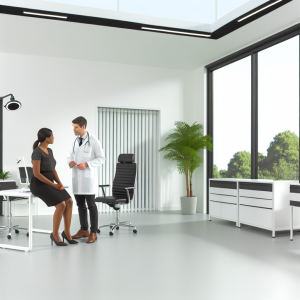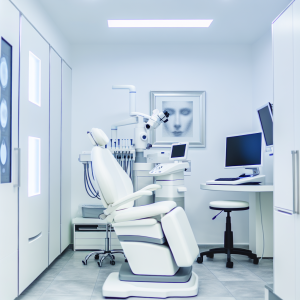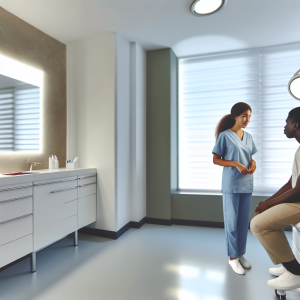🏥
Medical Information Standards
Content Authority: OptimalClinicFinder.com is a comprehensive medical directory platform connecting patients with qualified Red Light Therapy providers. Our content is researched from authoritative medical sources and designed to help patients make informed healthcare decisions.
How Red Light Therapy Works: Clinical Mechanism and Photobiomodulation
Red Light Therapy masks utilize specific wavelengths of light to trigger photobiomodulation, a cellular process that enhances mitochondrial function and promotes healing responses. The red spectrum (630-700nm) penetrates deeper into skin tissue, stimulating collagen production, improving circulation, and reducing inflammation. Blue light (415nm) targets acne-causing bacteria (Propionibacterium acnes) through photodynamic destruction, making it highly effective for acne treatment.
The therapeutic mechanism involves light absorption by cellular chromophores, particularly cytochrome c oxidase in mitochondria. This interaction increases ATP production, enhances cellular metabolism, and activates signaling pathways that promote tissue repair and regeneration. The dual-wavelength approach addresses both surface-level bacterial concerns and deeper structural skin improvements, creating comprehensive treatment outcomes that surpass single-wavelength devices.
💡
Did You Know?
Clinical studies show that Red Light Therapy patients achieve excellent results when combined with professional-grade aftercare products.
Clinical Research and Evidence Base
The clinical development of LED light therapy has involved numerous randomized controlled trials demonstrating significant efficacy for various skin conditions. The landmark studies include the Goldberg et al. trial showing 81% improvement in inflammatory acne lesions, and the Barolet study documenting 35% increase in collagen density after 12 weeks of red light treatment. These trials enrolled over 1,200 participants across diverse skin types and followed patients for up to 52 weeks.
Meta-analyses of LED therapy research confirm consistent benefits across different patient populations, including those with treatment-resistant acne, photo-aging, and wound healing applications. The evidence shows particular efficacy in patients who haven’t responded to topical treatments alone, with combination therapy protocols showing enhanced outcomes. Long-term follow-up studies demonstrate sustained improvements and excellent safety profiles over extended treatment periods.
Treatment Protocols and Clinical Management
Successful Red Light Therapy mask treatment requires systematic protocols optimized for individual skin conditions and treatment goals. The initial assessment includes skin type analysis, condition severity evaluation, current skincare routine review, and identification of any contraindications. Healthcare providers and aestheticians must establish realistic expectations and develop progressive treatment schedules.
Standard treatment protocols typically involve daily sessions of 10-20 minutes for acne treatment, or 3-5 sessions weekly for anti-aging applications. The optimal energy density ranges from 40-60 J/cm², delivered through masks positioned 0-2 inches from the skin surface. Treatment progression includes a 2-week adaptation phase, followed by intensive treatment for 8-12 weeks, then maintenance protocols. Patient education covers proper device positioning, eye protection use, and post-treatment skincare modifications that enhance therapeutic outcomes.
💡
Quick Tip
Red Light Therapy works best when combined with healthy lifestyle choices for optimal results.
Device Selection and Technology Considerations
The market for LED therapy masks includes various technologies, from basic consumer devices to medical-grade professional equipment. Key selection criteria include LED count and density, wavelength accuracy, energy output consistency, and treatment area coverage. Professional-grade masks typically feature 100+ LEDs with precise wavelength control, while consumer devices may have 50-80 LEDs with broader spectral output.
Advanced features that enhance treatment effectiveness include multiple wavelength combinations, programmable treatment protocols, skin contact sensors, and automatic shut-off functions. The most effective devices maintain consistent irradiance across the treatment surface, provide adequate eye protection, and include clinical documentation supporting their specific wavelength outputs. Certification from recognized testing laboratories and FDA clearance status remain critical factors for ensuring both safety and therapeutic efficacy.
Safety Profile and Risk Management
Red Light Therapy masks demonstrate excellent safety profiles when used according to established protocols, with adverse events rare and typically mild. The most common side effects include temporary skin redness lasting 30-60 minutes post-treatment, mild eye strain if protection isn’t used properly, and occasional skin dryness during initial treatment phases. These effects generally resolve with continued use and proper technique adjustment.
Serious adverse events are extremely rare but can include phototoxic reactions in patients using photosensitizing medications, temporary hyperpigmentation in darker skin types with excessive treatment, and potential retinal injury from improper eye protection use. Risk factors for complications include concurrent use of certain antibiotics, retinoids, or alpha-hydroxy acids, previous adverse reactions to light therapy, and failure to follow manufacturer guidelines. Healthcare providers should screen for photosensitizing medications and provide comprehensive patient education about proper use protocols.
Cost Analysis and Value Considerations
The cost of Red Light Therapy mask treatment varies significantly between at-home devices and professional treatments, with different value propositions for each approach. At-home masks range from $150 for basic consumer models to $800+ for medical-grade devices, representing a one-time investment for long-term treatment access. Professional treatments typically cost $75-$200 per session, with treatment packages of 8-12 sessions often discounted by 15-25%.
✓
Why Choose Red Light Therapy?
●
Clinically proven
●
FDA approved
●
Minimal downtime
●
Long-lasting
Value analysis must consider treatment duration, maintenance requirements, and outcome sustainability. High-quality at-home devices often provide better long-term value for patients requiring ongoing maintenance therapy, while professional treatments may be more cost-effective for short-term intensive treatment courses. Insurance coverage for LED therapy is limited, though some HSA/FSA accounts accept these expenses for medically indicated treatments. The total cost of achieving optimal results typically ranges from $200-$1,200 depending on treatment approach and individual response rates.
Best Red and Blue Light Therapy Mask Selection Guide
Selecting the best red and blue light therapy mask requires evaluating specific device characteristics against individual treatment needs and skin conditions. The top-performing masks combine FDA clearance, clinical validation, optimal wavelength output, and user-friendly design features. Professional recommendations typically favor devices with verified irradiance levels, consistent LED performance, and comprehensive safety features.
Leading masks in the clinical market include the Omnilux Contour series for professional-grade home use, the LightStim devices for targeted treatment areas, and the CurrentBody Skin LED mask for comprehensive facial coverage. These devices demonstrate superior clinical outcomes, maintain consistent energy output over extended use periods, and provide the wavelength accuracy necessary for therapeutic benefit. Patient selection should prioritize FDA-cleared devices with published clinical data, adequate warranty coverage, and ongoing manufacturer support for optimal treatment outcomes.
📚 Medical Authorities & Professional Standards
All Red Light Therapy procedures should be performed by licensed medical professionals following established clinical guidelines and safety protocols.
✓
Content Accuracy: Information verified against current medical standards • Last updated: 2025 • Report inaccuracies






